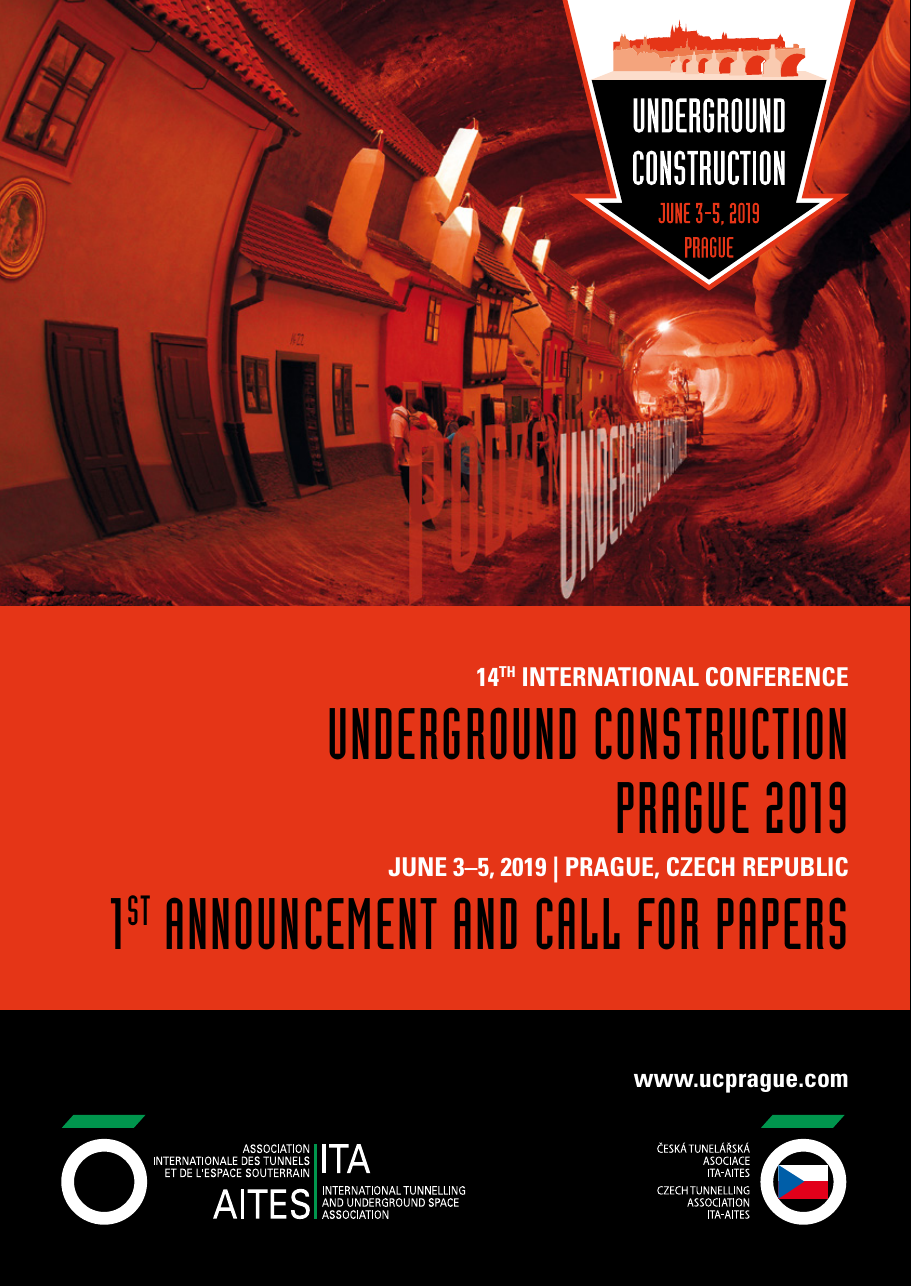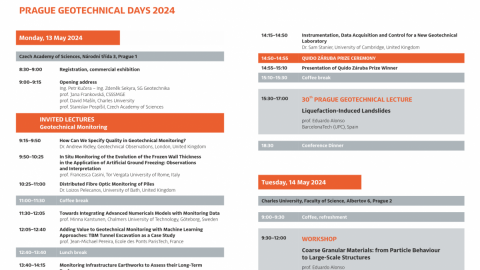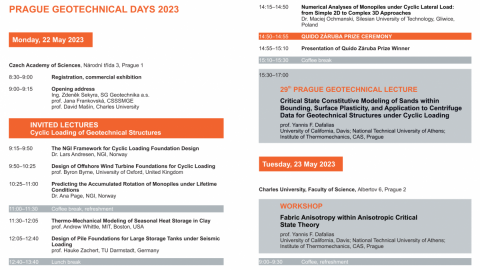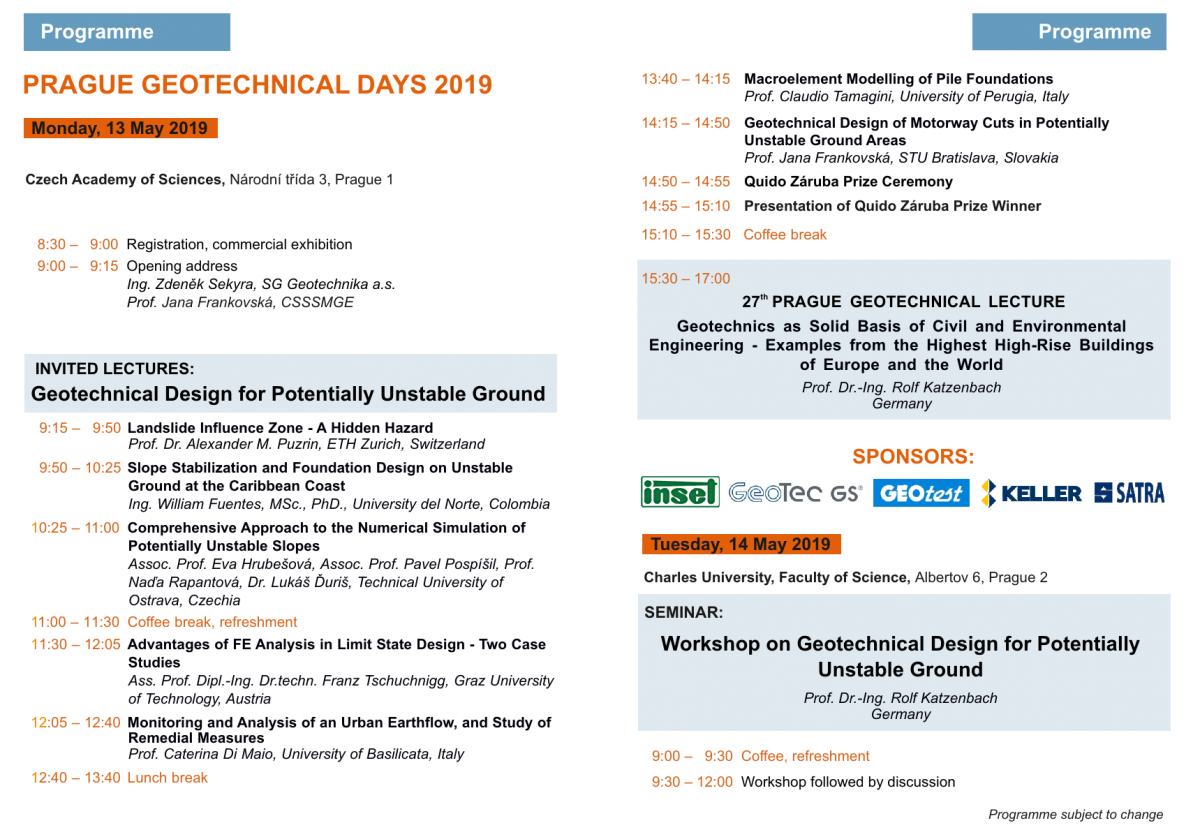Course “Hypoplasticity for Practical Applications”
A PhD-level course intended for both academia and practitioners.
Typical course duration is four or five three-hour long sessions (each session with one break). The course thus typically takes two days (9AM-12AM, 2PM-5PM), two and a half days (morning session only last day), or five days (morning sessions only). I adjust the course syllabus based on the focus of the audience. I charge per-hour teaching fee and travelling costs. Organisers are free to open the course to external participants and charge a registration fee (amount of their choice) to cover the costs. If you would like to run the course at your institution, let me know.
Forthcoming courses:
No course is scheduled by now.
Previous courses:
- Zhejiang University, Hangzhou, China, 10-11. 7. 2017. Reference: Prof. Lizhong Wang, Dr. Yi Hong
- Technische Universität Wien, Austria, 20-21. 3. 2017. Reference: Univ.Prof. Dipl.-Ing. Dr.techn. Dietmar Adam
- Christian-Albrechts-Universität zu Kiel, Germany, 7-10. 3. 2016. Reference: Prof. Dr.-Ing. Frank Wuttke, Dr.-Ing. Henning Stutz
- Zhejiang University, Hangzhou, China, 23-30. 6. 2015. Reference: Prof. Lizhong Wang, Dr. Yi Hong
- Charles University in Prague, Czech Republic, 16-17. 9. 2014. Reference: me
- The Hong Kong University of Science and Technology, 16-17. 2. 2012. Reference: Prof. Charles W. W. Ng
- University of Stuttgart, Germany, 18-20. 1. 2012. Reference: Univ. Prof. Dr.-Ing. habil. Christian Moormann
- University of Western Australia, Perth, 21. 1. 2011. Reference: Dr. Britta Bienen.
- National University of Singapore, 11-14. 1. 2011. Reference: prof. Siew Ann Tan
Objectives:
Hypoplasticity is an approach to constitutive modelling of geomaterials, which proved to be successful in modelling the non-linear state dependent soil behaviour. These aspects were found to be critical in a wide range of applications, starting with the impact of underground works (tunnels, deep excavations) on existing infrastructure, continuing with design of offshore foundations and ending with predictions of nuclear waste disposal facilities. The aim of the course is to provide a comprehensive review of the practically applicable versions of hypoplastic models. The course starts with an overview of the granular soil and fine-grained soil behaviour. Subsequently, hypoplasticity is set up within the broader constitutive modelling framework (Part 1). Mathematical formulation of hypoplasticity is later described in detail and two basic models are introduced: model for granular materials and model for clays (Part 2). Both these models can be enhanced by the so-called intergranular strain concept for small strain stiffness predictions, which is described in Part 3 of the course. Emphasis is put on description of procedures for calibration of the model parameters (Part 4). The students are given a single-element software to run element tests using hypoplasticity and they are given a task to calibrate the models themselves using example experimental data on clays and sands. In the Part 5 of the course, examples of practical applications of hypoplastic models are be presented. Finally, Part 6 is introducing a number of advanced topics, which may be important for solving specific case studies.
Example:
Handouts of Part 4 (“Determination of material parameters”), including a section of Part 6 on the effects of clay structure.
Outline:
Part 1: Introduction
- Outline of the course
- Fundamentals of soil behaviour
- Non-linearity of soil behaviour
- Asymptotic states
- Discrete element modelling of asymptotic states
- Basics of soil constitutive modelling
- Basic definitions
- Elasto-plasticity
- Simple 1D hypoplastic model
Part 2: Hypoplasticity – theory
- Classification of constitutive models
- Non-linearity and incremental non-linearity
- Response envelopes
- Development of hypoplastic constitutive models
- First hypoplastic equations (1985-1992)
- Comprehensive model for granular materials (1994-1996)
- Further developments of basic hypoplasticity (1997-2005)
- Explicit incorporation of asymptotic states
Part 3: Modelling small strain stiffness in hypoplasticity
- Modelling small strain stiffness in hypoplasticity
- Introduction
- Rachetting in hypoplasticity
- Intergranular strain
- Hypoplastic equation with intergranular strain in 1D
- Hypoplastic equation with intergranular strain in 3D
Part 4: Determination of material parameters
- Determination of material parameters
- Sand hypoplastic model (von Wolffersdorff, 1996)
- Clay hypoplastic model (Mašín, 2014)
- Intergranular strain concept (Niemunis and Herle, 1997)
Part 5: Hypoplasticity in finite element analysis
- Finite element implementation of hypoplasticity
- soilmodels.info project
- Hypoplasticity implementation as umat
- Hypoplasticity in PLAXIS
- Examples of applications
- Excavation of Komorany tunnel in sand
- Cyclic lateral response of a pile in soft clay
- Foundations of offshore structures
- Class A predictions of a NATM tunnel in stiff clay
- Embankment on lumpy clay landfill
- Deep excavation in soft clay
Part 6: Advanced modelling approaches
- Modelling the effects of structure (fabric, bonding, crushing)
- Stiffness anisotropy
- Rate effects
- Unsaturated soils
- Expansive soils
- Thermal effects
Tags: abaqus excalibre geo5 geoslope hypoclay hyposand idriver plaxis soiltest tochnog tochnogdriver triax








Dear professor Mašín,
I am sorry to trouble. Is it possible to attend this course for people from other universities?
If yes, where and when will be the next session?
Best Regards,
Aleksandr Dudchenko
Dear Александр,
As for me, you are of course welcome, though at the end it depends on organisers whether they decide to open it to external participants (in most cases they do). I will let you know once next course is scheduled.
Regards David
Dear David,
thanks a lot! I will wait for the information from you.
Best Regards,
Aleksandr Dudchenko
Dear professor Mašín,
I am sorry to trouble. Is it possible to organize a course through online video teaching.
If yes, when will be the next session?
Best Regards,
Haoran OuYang